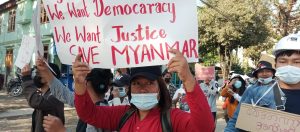Kalay (or Kalaymyo) in Myanmar’s northwestern Sagaing Region was among the first zones in the country to revolt against the military coup more than two years ago.
The story of Kalay’s emergence as a resistance hotspot began to take shape on February 1, 2021, just a couple of hours after news trickled out from Naypyidaw that the democratically elected government had been toppled by the military. A group of students huddled to discuss the ramifications of the momentous incident. The discussions lasted only for a couple of hours, but the foundation had been laid for the valley to implode into a formidable stronghold of resistance against the junta.
The irregular meetings convened by the Kalay University Students’ Union and the All Burma Federation of Student Unions soon began to attract more participants, with members from civil society groups and political functionaries also pitching in to give shape to a plan for peaceful demonstrations. The protest that started on February 6, 2021, continued for a month. With the number of protesters steadily swelling, the junta launched a crackdown in the second week of March.
“Some protesters were arrested and there were incidents of shooting by the regime forces,” said a functionary of the Kalay People’s Defense Force (Kalay PDF). “The turning point came on March 27 [2021], which coincides with Myanmar’s Armed Forces Day. There was a decision by several groups of protesters to take up arms against the junta.”
The consequence was the formation of two resistance groups – the Tahan Civil Defense Force (TCDF) and Kalay Civil Army (KCA) – and the erection of barricades on the main road of the city. In the brutal crackdown that started at 3 p.m. on March 28, hundreds of troops began to shoot at the protesters, who were armed with single-barrel guns and homemade weapons called tumi, typically used for hunting.
The gun battle continued until about 7 p.m., leaving at least eight people dead, including three women, and 10 injured. Some resistance fighters claimed that the regime forces suffered more casualties in the encounter, which could not be independently verified. The agitators dispersed and the regime forces smashed their barricades with backhoes.
The episode was only the start of a bloody confrontation.

































